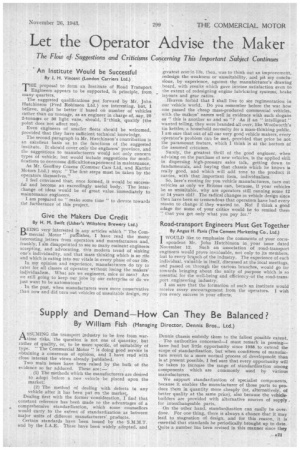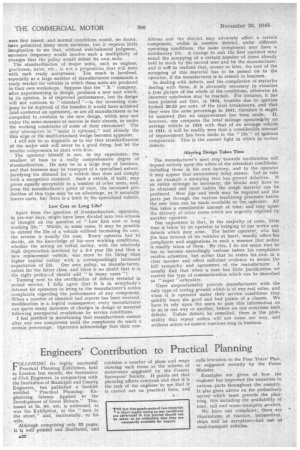Supply and Demand—How Can They Be Balanced ?
Page 23

Page 24

If you've noticed an error in this article please click here to report it so we can fix it.
By William Fish (Managing
Director, Dennis Bros., Ltd.)
ASSUMING the transport industry to be free from wartime risks, the question is not one of quantity, but rather of quality, or, to be more specific, of suitability of type. "The Commercial Motor" is doing good service in obtaining a consensus of opinion, and I have read with close interest the views already 'published.
Two main issues have been raised by the bulk of the evidence so far adduced. These are: (1) The methods which the manufacturers are desired to adopt before a new vehicle be placed upon the market; .
(2) The method of dealing with defects in any vehicle after it has been put on the market,. Dealing .first with the former 'consideration, I find that constant reference has been made to the advantages of a comprehensive standardization, which some counsellors would carry to the extent of standardization as between major units of different manufacturers' products. Certain standards have been issued by the SiVI.M.T. and by the I.A.E. These have been widely adopted, and Dennis chassis embody them to the fullest possible extent. . The authorities concerned—I must remark in passing— have had but little opportunity since 1938 to extend the scope of :standardization, but when conditions of manufacture revert to a more normal process of development than is at present possible, I feel sure that eyery opportunity will be taken to increase the range of standardization among components which are commonly used by various manufacturers.
We support standardization of specialist components, because it enables the manufacturer of those parts to 'produce them in quantity more cheaply (or, alternatively, of better quality at the sanie price), also because the vehiclebuilders are provided with alternative sources of supply, for interchangeable parts.
On the other hand, standardization can easily be overdone. For onething, there is always a chance that it may lead to stagnation of design, and for this reason, it is essential that standards he periodically, brought up to date. Quite a number has been revised in this manner since they
were first issued, and normal conditions would, no doubt, shave permitted many more revisions, but it requires little imagination to see that, without well-balanced judgment, excessive frequency would involve such a multiplicity of changes that the policy would defeat its own ends.
The standardization of major units, such as engines, gearboxes, axles, etc., is not a proposition ,that will meet with such ready acceptance. Too much is involved, especially as a large number of manufacturers commands a ready market for vehicles in which these units are produced in their own workshops. Suppose that the " X " company, after experimenting in design, produces a new unit which, in its opinion, is of improved performance, but its design will not conform to " standard "—is the inventing company to be' deprived of the benefits it would have achieved (and conferred on operators), or are all manufacturers to be compelled to „conform to the new, design, whiCh may not enjoy the same measure of success in their chassis, or under the working conditions of sonie of their customers? The Onlyalternative is "make it optional,'.' and already the thin edge of the multi-standard wedge becomes apparent.
I will not be so dogmatic as to say that standardization of the major unit will never be a good thing, but let the smaller components be dealt with first.
The operator himself is not, in my experience, the smallest of bars to a really comprehensive degree of standardization. He may be in a large way of business, and that business may be transport of a specialized nature, justifying his deniand for a vehicle that does not comply with a recognized standard. Such a vehicle, if built, may prove equally acceptable to a number of other users, and, from the manufacturer's point of view, the increased production of this type may be an advantage, as it naturally lowers costs, but there is a limit to the specialized vehicle.
Low' Cost or Long Life?
Apart from the question of standardization, operators, in pre-war days, might have been divided into two schools of thought on the question of " Low first cost or long working life." Whilst, in sonie cases, it may be possible to extend the life of a vehicle without increasing its cost, the reverse is usually the case. Every operator had to decide, on his knowledge of his ,own working conditions, whether the saving on initial outlay, with the relatively high depreciation involved by a 3-4 year life and then a new replacement vehicle, was more to his liking than higher capital outlay with a correspondingly increased expectation of life. Our own policy, as manufacturers, caters for the latter class, and there is no doubt that it is the right policy—I should add "in many cases "1
s Turning now to the rectification of defects revealed in actual service, I fully agree that it is in everybody's interest for operators to bring to the manufacturer's notice complaints regarding the performance of any component. When a number of identical bad reports has been received, modification is a logical consequence; every manufacturer can quote many. instances of chatiges in design or. material following unexpected revelations by service conditions.
I feel justified in maintaining that manufacturers cannot alter any one component until the complaints do reach a certain percentage. Operators acknowledge that their con. ditions and the • district may adversely affect a certain component, whilst in another district, under different operating conditions, the same component may have a satisfactory life. A change to suit the first operator may entail the scrapping of a certain. number of items already held in stock by the second user and by the manufacturer, and it will be realized that, sooner or later, the cost of the scrapping of this material has to •be passed on to the operator, if the manufacturer is to remain in business.
In dealing with defects, and the compilation of statistics dealing with them, it is obviously necessary to visualize a true picture of the whole of the conditions, otherwise an incorrect cpnclusion may be reached. For instance, it has been pointed out that, in 1924, troubles due to ignition formed 20-23-per cent. of the total breakdowns, and that they were the same percentage in 1941; therefore it might be assumed that no improvement has been made. If, however, one compares the total mileage operated, by an average vehicle in 1924 with that of an average vehicle in 1941, it will be readily seen that a considerable amount of improvement has been made in the " life" of ignition components. This is the correct light in which to review defects.
Altering Design Takes Time
The manufacturer's next step towards rectification will depend entirely upon the whole of the attendant conditions, including those in his own factory, and to the operator it may appear that unnecessary delay ensues. Let us take as an example a stamping that has .proved defective. It an entire redesign be necessary, die blocks may have to be obtained and recut before the rough material can be produced. New jigs and tools may be required and the parts put through the various machining processes before the new item can be made available to the operator. All this takes a considerable amount of time,and may upset the delivery of other items which are urgently required by
another operator. — • Our experience is that, in the majority of cases, little time is taken by an operator in bringing to our notice any defects which may arise. The better operator, who has the true interest of his vehicles at heart, usually offers his complaints and suggestions in such a manner that notice is readily taken of them. By this, I do not mean that he has to become exceedingly verbose before his complaints receive attention, but rather that he states his case in a clear manner and offers sufficient evidence to secure the full sympathy and agreement of the manufacturer. I
usually find. that when case has little justification we receive the type of communication which can be described
as " super "-articulate. '
Users unquestionably provide manufacturers with the only type of testing ground which is of any real value, and when it is operated under their service conditions they_ quickly learn the good and bad points of a chassis. We have to rely upon the users to pass this information on to us. in one way or another, before we can overcome such defects. Unless defects be. remedied, there is the probability that repeat orders will not come our way, and without orders we cannot continue long in business.




















































